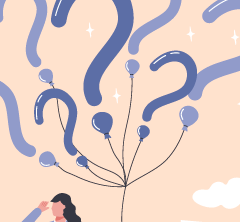Last updated on
Yoga: The Medicine You Didn’t Know You Needed
Yoga is an ancient Hindu discipline that’s centered around holding the body in different positions. While doing yoga, practitioners focus on controlling their breathing, clearing their minds, and challenging their bodies. Yoga brings many people a sense of calm and helps them deal with the anxiety and stress of everyday life.
If you’ve had a blood clot, you’re probably no stranger to stress and anxiety, and yoga is a great tool to help you manage these feelings. “Yoga is like moving meditation. You get to move and clear your head. It’s amazing what an hour class gives you after you leave,” said Jennifer Hedstrom, a yoga practitioner and instructor. “It gives you a sense of new beginning and peacefulness. I notice in my own life that I can take a step back and look at things a little differently.”
Jennifer started out as an avid runner but after being diagnosed with arthritis, she needed to find an exercise that wouldn’t harm her joints. That’s when she started doing yoga. As a teacher, she now helps her students embrace both the benefits and challenges that come with practicing yoga.
Embrace the challenge
Yoga can be challenging, both mentally and physically. “It’s challenging for many reasons,” Jennifer noted. “Some people have a hard time being in an environment that’s really quiet where they’re alone with their own thoughts in their heads.”
Many people avoid yoga because they tell themselves that they can’t do it. They may feel like they aren’t flexible enough, young enough, or fit enough – but that isn’t the case. Anyone can do yoga if they just give it a try.
“People think that because they’re not flexible or they’re older or they’re injured, they can’t handle the quicker pace,” explained Jennifer. “That’s the biggest thing to learn, coming out of the exercise gym world and into the yoga studio. First of all, no one cares what you’re doing on your mat. There’s no competition with the person next to you. You’ll just learn to listen to your body and not judge what’s going on around you or how you feel that day.”
Although a yoga class can have people of different skill levels, instructors have ways of making the class appropriate for everyone.
“We always ask if there are any injuries,” said Jennifer. As a yoga instructor, she’s there to help each student reach a level of practice that’s personally challenging without being overwhelming. “For everything we do, there are accommodations, such as dropping knees, dropping arms, changing breaths, or maybe not holding a pose as long.”
Different types of yoga also fit a person’s needs differently. Hatha is a form of yoga that involves slower movements and can be gentler on the body. In comparison, vinyasa is more movement-intense.
At any point in any type of yoga class, students can go into a position known as child’s pose where a person kneels on the ground and rests their forehead on their yoga mat. It’s a restorative pose that is meant to help yoga practitioners rest.
The science behind yoga
It’s well-known that exercise can help improve mood and relieve anxiety; and research suggests that yoga shows a similar pattern. Yoga exerts this powerful effect because it increases GABA levels in the brain. GABA is a neurotransmitter that helps brain cells communicate with each other. When GABA levels are low, stress and anxiety can develop.
In addition to raising the brain’s GABA levels, the slow breathing and meditation in yoga also strengthen the body’s parasympathetic nervous system, which works to slow the heart and lower blood pressure. A stronger parasympathetic nervous system helps balance the body’s reaction to stressful situations that are triggered by the sympathetic nervous system. Unlike the parasympathetic system, the sympathetic nervous system raises blood pressure and heart rate during times of stress – also known as the “fight-or-flight” response.
Patients who experience stress-related issues or depression/anxiety disorders usually experience an imbalance where their sympathetic nervous system is working more than their parasympathetic nervous system, according to Dr. Chris Streeter, an Associate Professor of Psychiatry and Neurology at Boston University School of Medicine.
One study that analyzed the effects of yoga in women with depression and anxiety found that after attending a two-month yoga class, participants experienced decreased levels of anxiety. Researchers concluded that yoga could serve as a complementary form of therapy for patients with anxiety disorders. If you’ve experienced anxiety after a blood clot, yoga may be just what the doctor ordered.
Getting started
Finding your local yoga studio is only a Google search away.
Many studios offer different types of yoga geared towards different needs. Looking to ease into the yoga world? Try a class geared towards beginners or a restorative yoga class. Restorative yoga involves fewer poses and is meant to be relaxing. Would you rather try a more physically challenging class? Try hot yoga where the room is heated to 80-100 degrees Fahrenheit.
If you think you’d like to start practicing yoga (or any other form of exercise), consult with your healthcare provider before getting started.



